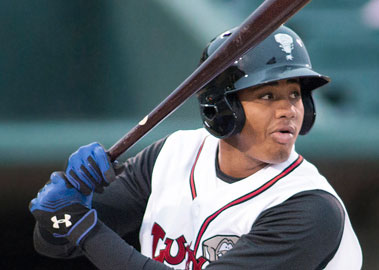
Image from LansingLugnuts.MLBlogs.com.
20. Dawel Lugo | SS
| Year | Age | Level | AB | 2B | 3B | HR | BB | K | SB | CS | AVG | OBP | SLG |
| 2012 |
17 |
RK |
170 |
2 |
5 |
2 |
7 |
25 |
5 |
1 |
.224 |
.275 |
.329 |
| 2013 |
18 |
RK+ |
192 |
11 |
2 |
6 |
5 |
28 |
1 |
0 |
.297 |
.317 |
.469 |
| 2013 |
18 |
A- |
69 |
4 |
0 |
1 |
1 |
13 |
0 |
0 |
.246 |
.257 |
.348 |
| 2014 |
19 |
A |
474 |
17 |
2 |
4 |
18 |
72 |
3 |
3 |
.259 |
.286 |
.329 |
The Blue Jays signed Dawel Lugo for $1.3 million in 2011. The Dominican shortstop skipped the Dominican Summer League and came straight to the United States in 2012. As a 17-year-old, Lugo hit .224 with 7 walks and 25 strikeouts in 170 at-bats. While the numbers were not impressive, this was Lugoís first season in the United States and his first exposure to professional baseball.
The following season Lugo graduated to Bluefield and he spent most of the year in the Appalachian League before appearing in 16 games for the Canadians. Lugo demonstrated the offensive potential that attracted a seven-figure signing bonus in Bluefield with a .297 batting average and a .469 slugging percentage. Lugo finished with the eighth-highest slugging percentage in the Appalachian League, while also being the tenth-youngest player in the league. He continued to make contact at a decent rate with 28 strikeouts in 192 at-bats, but he did display an even more noticeable lack of patience at the play and only drew five walks with Bluefield.
In a little bit of a surprise, the Jays didnít send Lugo back to Vancouver for the 2014 season, but instead assigned him to Lansing in the Midwest League. Lugo struggled a little with the assignment, hitting .259 and only slugging .329. In 498 plate appearances, he struck out 72 times and only drew 18 walks.
Scouts donít think itís likely that Lugo will stick at shortstop, but he hasnít had to move from the position yet. He was signed with the expectation heíd end up as a third baseman, but he has reportedly been better than expected defensively since arriving in professional baseball. His lateral quickness is a weakness and he may still wind up at third base. The long-term plans for Lugo may become clearer if he spends next season at a different level than Mitch Nay, who manned third base for Lansing this season.
With his bat as his calling card, Lugoís offensive potential is limited by his lack of plate discipline, which hasnít shown any significant improvement yet. Only 19, he still has time on his side, but unless Lugo can moderate an aggressive approach with some demonstrated ability to recognize pitches and take a walk when appropriate, he will continue to be exposed as he climbs up the ladder. However, if he can show moderate improvement to that element of his game, his strong hand-eye coordination and quick bat speed provide significant offensive potential thatís still developing. Lugo is still several years away, even in a best-case scenario, but he has a potential impact bat if everything breaks right. However, Lugo will need to make adjustments for that to be the case, which he hasnít shown the ability to do so far.
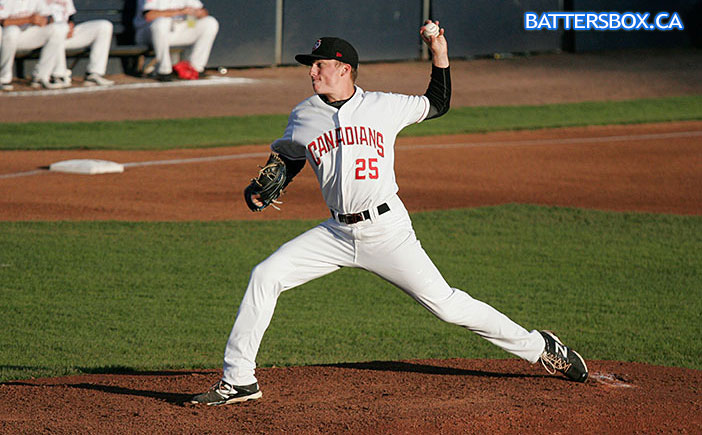
19. Ryan Borucki | LHP
| Year | Age | Level | G | GS | IP | H/9 | HR/9 | BB/9 | K/9 | ERA |
| 2012 |
18 |
RK |
4 |
0 |
6.0 |
6.0 |
1.5 |
0.0 |
15.0 |
3.00 |
| 2014 | 20 |
RK+ |
8 |
6 |
33.1 |
7.0 |
0.5 |
1.6 |
8.1 |
2.70 |
| 2014 | 20 |
A- | 5 |
4 |
23.2 |
4.9 |
0.4 |
1.1 |
8.4 |
1.90 |
A high-school pitcher from Mundelein High School in Mundelein, Illinois, Ryan Borucki was selected in the 15th round of the 2012 amateur draft after his senior season. The draft buzz around Borucki had intensified over the year prior to the draft, as the southpaw was only 5í8 at the beginning of Grade 11, but had a growth spurt and was 6í3 by the middle of his senior season.
However, Borucki pitched sparingly during his senior season due to a ligament tear in his elbow. As of May 1, 2012, Borucki had only pitched 14.2 innings that season and had struck out 26 of the 52 batters he faced. He opted to avoid Tommy John surgery in favour of rest and rehab for his elbow. Nonetheless, the Jays selected Borucki in the 15th round and spent $426,000 to sign him away from a scholarship to the University of Iowa. He was the only player selected in that round of the draft to receive a signing bonus over the $100,000 limit.
There is a history of professional baseball in the Borucki family, as his father, Ray Borucki, was an infielder for both the Philadelphia Phillies and Detroit Tigers and made it as far at Triple-A. Listed at 6í4 and 175 pounds, Borucki was sent to the Gulf Coast League where he made four appearances, facing 22 batters. He allowed four hits, including one homer, but struck out ten of those hitters.
Unfortunately, Borucki blew out his elbow in 2013 and missed the season after undergoing Tommy John surgery. He didnít return to the mound until the middle of 2014. Borucki split the 2014 season between Bluefield and Vancouver, making 10 starts and three relief appearances. After six starts with Bluefield, he was promoted to Vancouver, where he made his final four starts of the year. Over the full season, he struck out 52 batters in 57 innings and put up a 2.37 ERA.
It was reported that this year Boruckiís fastball comfortably sat in the 88-92 miles per hour range. Prior to the draft, reports from both Jim Callis and a pre-draft prep event had Borucki sitting in the low-90ís, so itís a little unclear if heís still working to regain fastball velocity post-surgery or if those reports may just have come from days when he was a little less sharp than others. Borucki also throws a change-up and a curveball.
Dane Johnson spoke to Batterís Box recently about Borucki and praised his intangibles, commenting, ďHe has the intangibles on the mound that you like to see, especially from a kid his age, that are far above what you would normally see from a kid that age.Ē Johnson also reported that they had Borucki lay off his breaking pitches towards the end of the season and that he still needs progress with his curve ball to make it more of a strikeout weapon. If he can add the curveball and slider, Borucki would become a four-pitch pitcher and, as Johnson noted, ďThen you would be looking at a guy with a four pitch mix and the intangibles he has on the mound, game management, holding runners and all that. That's a nice package obviously.Ē
With his sharp control and projectable frame, he is definitely a pitcher worth watching in 2015. Given Boruckiís injury history, it seems likely that he will be used in a tandem starter role to continue to rebuild his arm strength and limit his innings.
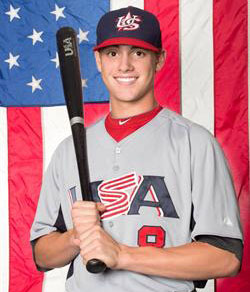
18. Lane Thomas | 2B
| Year | Age | Level | AB | 2B | 3B | HR | BB | K | SB | CS | AVG | OBP | SLG |
| 2014 |
18 |
RK |
131 |
8 |
4 |
0 |
21 |
33 |
7 |
3 |
.260 |
.362 |
.382 |
| 2014 |
18 |
RK+ |
65 |
4 |
0 |
1 |
6 |
16 |
2 | 0 | .323 |
.384 |
.431 |
The Jays have had mixed results in drafting high school hitters over the last few years. Kellen Sweeney, Chris Hawkins, Dickie Thon, DJ Davis, Jake Anderson, Dwight Smith Jr. and Mitch Nay were early draftees of the Jays. Most went to the GCL, hit a little and mainly got used to playing pro baseball every day. So when Lane Thomas was drafted in the fifth round this year, we expected more of the same. But Thomas surprised with his bat, he hit well, showed some speed and power and controlled the strike zone well for a first year player. His GCL performance earned him a trip to Bluefield for the last three weeks where he hit over .300 with an OPS over 800. This was a very encouraging start for a first year player. Thomas did play some for Team USA and that experience might have helped him get a quick start when compared to others in his class.
Thomas was drafted as an outfielder and the Jays had him play in center field and at third base. Thomas also played some shortstop in high school. Having seen him over the last three months ,the Jays have decided that Thomas profiles best at second base. In the instructional league which just finished, Thomas learned the second base position and will play there next year.
Thomas will likely play in Bluefield or Vancouver next season and look to improve on his hitting with his first year under his belt.
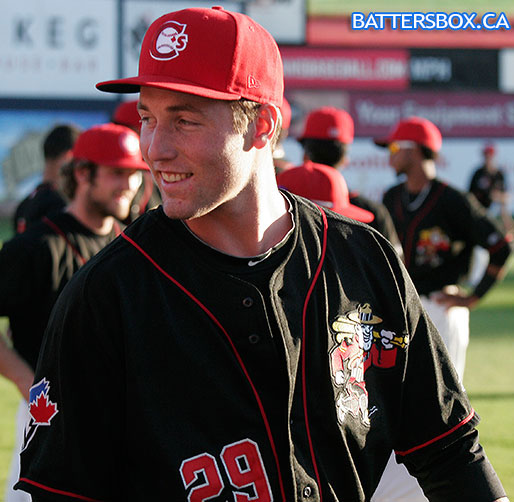
17. Sean Reid-Foley | RHP
| Year | Age | Level | G | GS | IP | H/9 | HR/9 | BB/9 | K/9 | ERA |
| 2014 |
18 |
RK |
9 |
5 |
22.2 |
8.3 |
0.0 |
4.0 |
9.9 |
4.76 |
Sean Reid-Foley was drafted by the Jays 49th overall in the 2014 draft out of high school in Florida. The Jays were able to sign Sean for slot which was $1.128 million. Sean was committed to Florida State, but the Jays took a gamble and were able to sign Sean as the consensus was that he was going to be a tough sign if he didnít get selected in the first round.
Sean pitched with the GCL Jays after he signed in 2014, and put up respectable numbers with a 4.76 ERA with 4 BB/9 and 9.9 K/9 as an 18 year old. Expect him to start 2015 in extended spring training, and appear in Bluefield once their short-season begins.
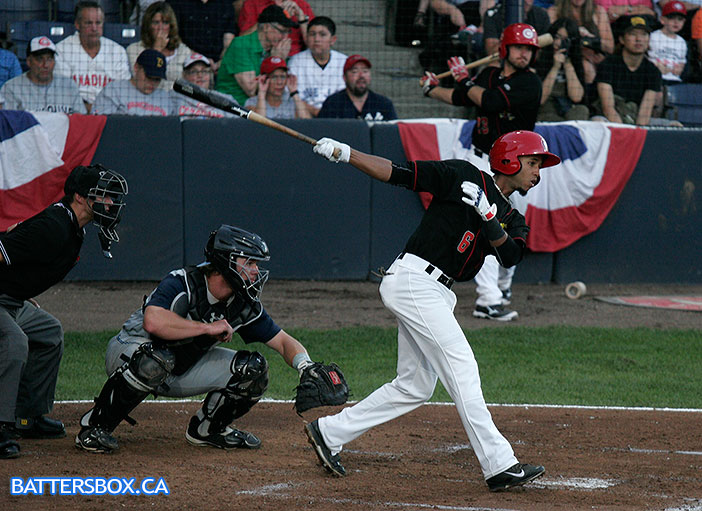
16. Richard Urena | SS
| Year | Age | Level | AB | 2B | 3B | HR | BB | K | SB | CS | AVG | OBP | SLG |
| 2013 |
17 |
RK- |
243 |
19 | 2 | 1 |
30 |
43 |
9 |
5 |
.296 |
.381 |
.403 |
| 2013 |
17 |
RK | 27 |
2 |
0 |
0 |
3 |
6 |
0 |
0 |
.333 |
.400 |
.407 |
| 2014 |
18 |
RK+ | 217 |
15 |
2 |
2 |
16 |
51 |
5 |
4 |
.318 |
.363 |
.433 |
| 2014 |
18 |
A- |
33 |
2 |
1 |
0 |
3 |
5 |
1 |
0 |
.242 |
.297 |
.364 |
Richard Urena was the less heralded of the two shortstop prospects signed during the international free agent signing period of 2012. Whereas Franklin Barreto may ultimately move off the position, Urena it is reported, has the tools to play the position as he moves through the system. His second season of professional baseball was encouraging from a number of standpoints. First, he started switch hitting. It is tough to learn to switch hit at any age but to learn it as a professional is a tough go. Urena did well at it with his stats decent from both sides. As a right-hander, his new side, he did hit for less power and with more strikeouts than from the left side. But for a first season he did well.
Baseball America named Urena as their number three prospect in the Appy League. It has been reported that Urena does everything well but nothing to extremes. To put it another way he is a good, not great, hitter; a good, not great, fielder and a good, not great, runner. Urena is just 18 years old so there is plenty of time to change that scouting report. Urena does have the tools to remain at short and that leads to the question of where Urena will play next year. The Jays would like Urena to stay at shortstop but Franklin Barreto is ahead of Urena in the depth chart and is slated to play short in Lansing. Given that Urena will still be just 19 next season he might stay in extended and head to Vancouver, or Lansing as a mid-season replacement if Barreto can earn a promotion.
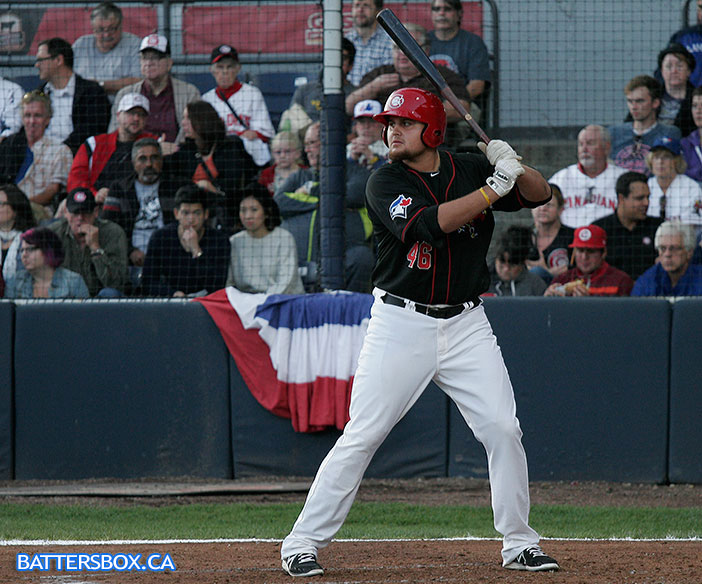
15. Rowdy Tellez | 1B
| Year | Age | Level | AB | 2B | 3B | HR | BB | K | SB | CS | AVG | OBP | SLG |
| 2013 |
18 |
RK |
124 |
5 |
3 |
2 |
15 |
26 |
1 |
0 | .234 |
.319 |
.371 |
| 2014 |
19 |
RK+ |
191 |
11 |
1 |
4 |
19 |
27 |
3 |
2 |
.293 |
.366 |
.424 |
| 2014 |
19 |
A- |
42 |
0 |
0 |
2 |
7 |
10 |
0 |
0 |
.357 |
.449 |
.500 |
Rowdy Tellez began to emerge with the bat in 2014 after a slow start. He got his feet wet in Bluefield last season when he was called up from the Gulf Coast League for their first round series to Pulaski. Things did not go well for Tellez and the Bluef-Jays as he drew just one walk in eight plate appearances in a two-game sweep by the Mariners. It took awhile for the Elk Grove, California native to get going with the stick as he hit just .162 with no home runs in June. He rebounded to hit .288 in July with a .357 on-base percentage in July but he really took off in August when he put together a slash line of .400/.458/.680 that included three of his four homers. It was midway through August when the left-handed hitter was called up to Lansing to help the Lugnuts in a last-ditch attempt to make the playoffs. Tellez did his part by hitting .357 with two home runs but the Lugnuts fell short of making it to the second season. Tellez did get to see action in the postseason when he was sent to Vancouver. He recorded a hit in his last playoff game and he hit a deep fly ball to center field that died at the warning track in Game 2 of the Northwest League final in what turned out to be a one-run loss in Hillsboro.
Tellez, who turns 20 on March 16, continues to work on his defence at first base as he made seven errors to give him a .986 fielding percentage. He will probably start 2015 back in Lansing.
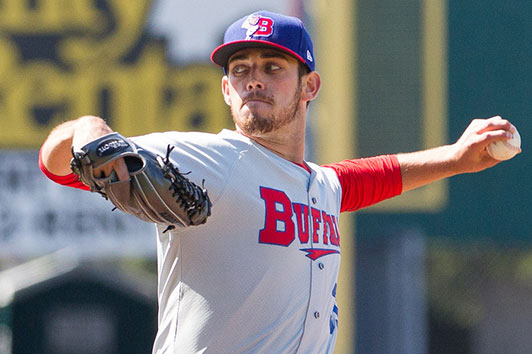
Image from MiLB.com.
14. Sean Nolin | RHP
| Year | Age | Level | G | GS | IP | H/9 | HR/9 | BB/9 | K/9 | ERA |
| 2010 |
20 |
RK |
1 | 1 | 2 |
4.5 |
0.0 |
4.5 |
18.0 |
0.00 |
| 2010 |
20 |
A- |
6 | 6 | 19.1 |
11.6 |
0.0 |
4.2 |
10.2 |
6.05 |
| 2011 |
21 |
A |
25 |
21 |
108.1 |
8.5 |
0.8 |
2.6 |
9.4 |
3.49 |
| 2012 |
22 |
A+ |
17 |
15 |
86.1 |
7.5 |
0.7 |
2.2 |
9.4 |
2.19 |
| 2012 |
22 |
AA |
3 |
3 |
15.0 |
5.4 |
0.0 |
3.6 |
10.8 |
1.20 |
| 2013 |
23 |
AA |
17 |
17 |
92.2 |
8.6 |
0.6 |
2.4 |
10.0 |
3.01 |
| 2013 |
23 |
AAA |
3 |
3 |
17.2 |
6.6 |
0.5 |
5.1 |
6.6 |
1.53 |
| 2013 |
23 |
MLB |
1 |
1 |
1.1 |
47.3 |
6.8 |
6.8 |
0.0 |
40.5 |
| 2014 |
24 |
RK |
1 |
1 |
2.1 |
3.9 |
0.0 |
0.0 |
19.3 |
0.00 |
| 2014 |
24 |
A+ |
2 |
2 |
7.1 |
4.9 |
0.0 |
4.9 |
11.0 |
3.68 |
| 2014 |
24 |
AAA |
17 |
17 |
87.1 |
7.6 |
0.6 |
3.6 |
7.6 |
3.50 |
| 2014 |
24 |
MLB |
1 |
0 |
1.0 |
9.0 |
9.0 |
0.0 |
0.0 |
9.00 |
Last yearís Batterís Box Top 30 ranked Sean Nolin as the teamís 4th best prospect and began the write-up by stating, ďSean Nolin gets no respect.Ē Itís possible we used that line a year too early. In any case, it would be just as, if not more, appropriate to repeat it again this year. Itís not often that a teamís fourth-best prospect posts a 3.50 ERA in 17 starts at Triple-A and falls 10 places in the prospect rankings.
However, the emergence of several lower-level hitting prospects and Daniel Norris, not too mention Kendall Graveman, have left Nolin somewhat of a forgotten man. While he was rewarded with a September promotion, Nolin only pitched one forgettable inning, while Graveman and Norris each made five appearances, which may be an indication of how the team views him in relation to the other two pitchers. Nolin also saw the front office tab Liam Hendriks for three starts ahead of him earlier in the season.
Nolin features a fastball that sits around 89-92 mph with an above-average change-up and two breaking balls. Prior to 2014, Nolin had demonstrated strong control of the strike zone, which included K/BB ratios of 3.65, 4.00 and 3.31 in the 2011, 2012 and 2013 seasons, respectively. However, this ratio fell to 2.26 in 2014. Somewhat worryingly, Nolinís career K:BB ratio at Triple-A is 1.93:1, compared to 3.90:1 at Double-A and 3.96:1 at High-A.
Nolin looks unlikely to open 2015 in Toronto, as the rotation is already crowded and, if there are additions to be made, they will likely come from outside the organization in an effort to bolster the front end of the rotation.
Nolin wasnít overly impressive at Buffalo and will likely hope to improve his command in an effort to establish himself as the sixth or seventh option for the team. Over his minor league career, Nolin has held lefties to a .566 OPS compared to .673 for right-handed batters, so there is a chance that Nolin could see time in Toronto in 2015 as a lefty specialist/longman in the Toronto bullpen.
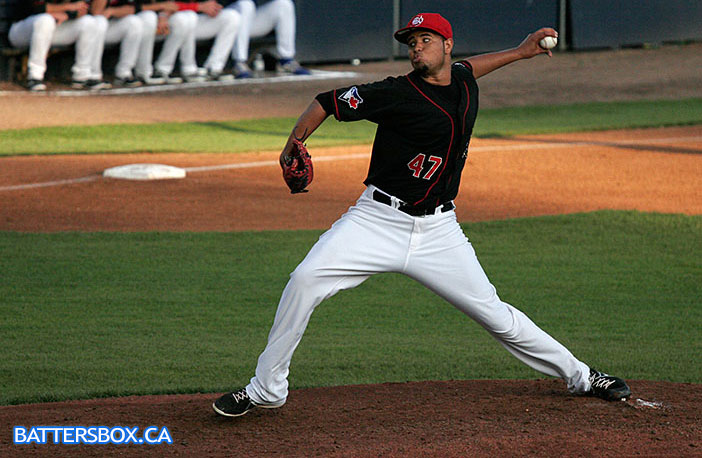
13. Jairo Labourt | LHP
| Year | Age | Level | G | GS | IP | H/9 | HR/9 | BB/9 | K/9 | ERA |
| 2011 |
17 |
RK- |
12 |
12 |
36.1 |
7.2 |
0.0 |
3.4 |
7.2 |
2.23 |
| 2012 |
18 |
RK |
12 |
12 |
38.0 |
9.0 |
0.5 |
5.5 |
9.2 |
3.79 |
| 2013 |
19 |
RK+ |
12 |
8 |
51.2 |
6.8 |
0.5 |
2.4 |
7.8 |
1.92 |
| 2014 |
20 |
A |
6 |
3 |
14.0 |
9.6 |
0.6 |
12.9 |
7.1 |
6.43 |
| 2014 |
20 |
A- |
15 |
15 |
71.1 |
5.9 |
0.0 |
4.7 |
10.3 |
1.77 |
Jairo Labourt, much like fellow Dominican hurler Alberto Tirado, had some trying times in Lansing to begin 2014. The 6-foot-4 lefty was part of the Lugnuts tandem rotation and like Tirado, he had trouble throwing strikes. Despite 4.1 scoreless frames over his last two appearances, Labourt wound up walking 20 batters over 14 innings, with half of those passes coming in two outings. He struck out 11 batters but a Fielders Independent Pitching mark of 7.77 led to Labourt being sent down to Florida for extended Spring Training.
Labourt told JaysProspects.com he had trouble adjusting to life in the bullpen because he had never been a reliever before and added it was tougher to find time to do his long tossing. Lansing pitching coach Vince Horsman also said Labourt had trouble keeping the ball down in April and needed to work on that in extended spring.
The work in Dunedin paid off as Labourt enjoyed a solid season season with Vancouver, teaming up to form a solid one-two punch with Miguel Castro in Vancouver for the first half of the Northwest League season. Their performances ranked them third and fourth in Baseball Americaís Northwest League Top 20 prospects. When asked why Labourt was rated ahead of Castro, BAís John Manuel pointed to Labourtís left-handedness, his ability to dominate older competition with his fastball and a clean arm action that should lead to improved command.
Labourt earned his first victory on Canadian soil on June 28 when he threw six shutout frames of no-hit ball with a 6-3 K-BB total against Tri-City. He was nearly part of a combined no-hit bid that was eventually spoiled in the eighth. The lowlight of his season was in late July when his scheduled start was pushed back a day because general manager Alex Anthopoulos was in Vancouver. Labourt was roughed up for four runs in four innings and walked five in a loss to eventual league champion Hillsboro. Still, monthly ERAís of 2.25 and 2.60 in June and July led to Labourt getting the starting nod for the North Division squad at the Northwest League All-Star Game in Eugene. He pitched a one-hit frame with one strikeout in a game that ended in a 0-0 tie. He really hit his stride in August by going 3-0 with an ERA of 0.65 to help the Canadians win the second half of the North Division title and make the postseason for the fifth consecutive year. One big key was his ability to chop down his walk rate to less than three walks per nine innings. He also struck out 33 batters in 27.2 innings.
Labourt made one postseason start and he delivered a one-run performance over six innings in Spokane in Game 2 of the North Division final to help Vancouver reach the league final for the fourth year in a row. He experienced playoff pressure before with the Cís, getting the start in Game 1 of the Northwest League final in 2013. He took the Game 1 loss in Boise but still managed to rack up 10 strikeouts. Labourt also pitched Game 1 of Bluefieldís playoff series against Pulaski last year, getting a no-decision after allowing four runs in five innings.
Labourtís fastball registered at 94-95 MPH and did reach 97. He also throws a slider at 84-85 and a change up in the low 80ís. His ground ball percentage shot up from 42 percent in Lansing to 54 percent in Vancouver. In terms of BABIP, it fell from .359 with the Lugnuts to .278 with the Canadians.
Signed as an international free agent in 2011 for $350,000 on his 17th birthday, Labourt turns 21 on March 7. He will probably get a do-over in Lansing to start 2015.
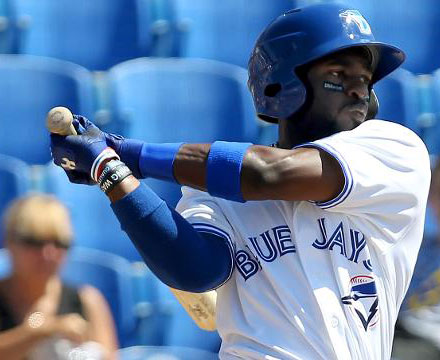
Image from MiLB.com.
12. Dwight Smith Jr | OF
| Year | Age | Level | AB | 2B | 3B | HR | BB | K | SB | CS | AVG | OBP | SLG |
| 2012 |
19 |
Rk |
159 |
6 | 0 | 4 |
11 |
22 |
1 |
1 |
.226 |
.289 |
.340 |
| 2013 |
19 |
A- |
63 |
3 |
1 |
0 |
6 |
11 |
0 |
0 |
.175 |
.254 |
.254 |
| 2013 |
20 |
A |
423 |
17 |
3 |
7 |
52 |
82 |
25 |
5 |
.284 |
.365 |
.388 |
| 2014 |
21 |
A+ |
472 |
28 |
8 |
12 |
58 |
69 |
15 |
4 |
.284 |
.363 |
.453 |
Big fan of Dwight Smith Jr. Pure hitter. Not too many of those around. In Dunedin at 21, Smith Jr. hit .284/.363/.453. Not big numbers for a corner outfield prospect, but hey, heís playing second base now. It seems as though it has been ages since the Jays have drafted and developed a pure hitter. It would be nice watching a Jays game and seeing professional at-bats more often. Smith Jr. will likely continue his odyssey next year in New Hampshire. He probably needs a season or two more with the glove now, but I imagine the bat will be there. The old adage that power is the last thing to come is probably true for Smith Jr., although heís more than a 10-15 HR type than 20-25. ![]()
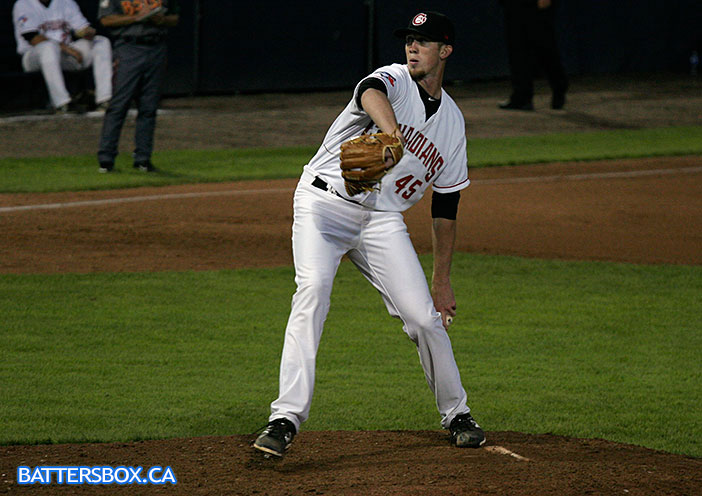
11. Matt Smoral | LHP
| Year | Age | Level | G | GS | IP | H/9 | HR/9 | BB/9 | K/9 | ERA |
| 2013 |
19 |
RK |
15 |
5 |
25.2 |
7.7 |
0.4 | 9.1 |
9.5 |
7.01 |
| 2014 |
20 |
RK+ |
9 |
5 |
33.2 |
8.3 |
0.0 | 4.8 |
13.6 |
3.48 |
| 2014 |
20 |
A- |
5 |
3 |
20.0 |
6.3 |
0.0 |
6.8 |
8.6 |
2.70 |
2012 draftee Matt Smoral made some strides this year. He pitched at two levels, putting up some encouraging numbers. In Bluefield he worked 33+ innings, striking out 51 and walking just 18. The walk though returned for Smoral in Vancouver where he walked 15 in 20 innings.
Control certainly will be an issue as Smoral progresses. His slow development thus far has been a combination of healing and delivery tinkering. He has a big body and getting all that coordinated can be challenging. Should he further develop some consistency with the delivery, there is some front-line potential. His combination of size, left-handedness and stuff is awesome. The fastball works in the low-90s and he has a wipeout slider. 2015 will be a big year for Smoral as he takes on full-season ball.




